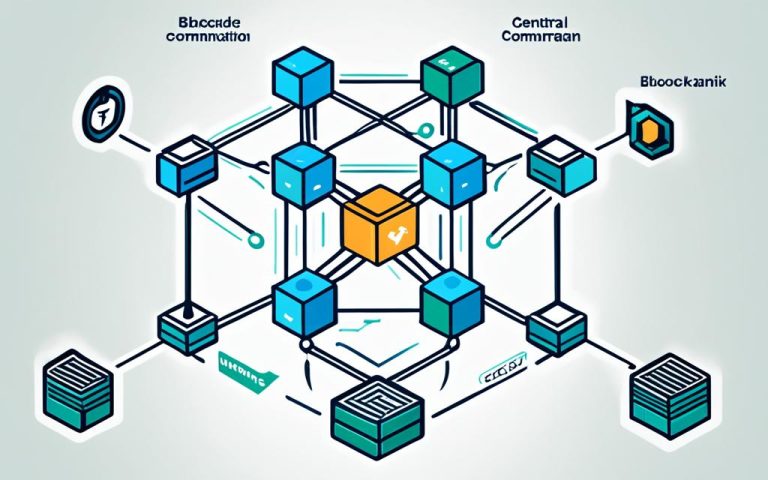Blockchain technology is changing many industries. Almost 81 out of the top 100 companies are exploring or using blockchain. It shows they see its benefits for improving work, safety, and openness.
To put blockchain into action, organizations need a plan. CompTIA lists seven steps for blockchain introduction that help guide companies.
Understanding Blockchain Technology and Types of Consensus Protocols
Learning about blockchain is the first step. It’s about teaching everyone in the company its value and how it can be used. For real-world examples, businesses can look at blockchain use cases in different fields.
It’s also key to know about consensus protocols, like Proof of Work (PoW) and Proof of Stake (PoS). For instance, Ethereum switched from PoW to PoS for better scale and less energy use. In PoS, to be a validator and help secure the network, one needs to stake 32 ETH.
Choosing the Right Blockchain Platform and Developing Smart Contracts
Choosing the right blockchain platform is crucial. Think about factors such as speed, compatibility with Ethereum Virtual Machine (EVM), and the importance of not being controlled by one entity. Also, think about costs, how well it can grow, safety, existing apps, and community support.
After picking a platform, the next step is to make smart contracts. These contracts automatically execute transactions on the blockchain. Since they deal with moving assets, doing thorough security checks on them is vital before they go live.
Conclusion
Introducing blockchain in an organization involves many steps. By adopting blockchain and strategic planning, companies gain better security, openness, and work efficiency. Staying current with blockchain trends and best practices is essential for ongoing success.
For more detailed advice on blockchain in business, check out our guide at how to implement blockchain in business. It offers insights and steps to start your blockchain project.
Understanding Blockchain Technology and Types of Consensus Protocols
Blockchain technology has changed many industries with its secure, decentralized ways. Consensus protocols at its heart are key for trust and confirming transactions.
There are different consensus protocols, each special in its way. Two well-known ones are Proof of Work (PoW) and Proof of Stake (PoS).
Proof of Work (PoW), used by Bitcoin, requires computational power to solve puzzles and add blocks. Miners race to solve these puzzles first to get cryptocurrency rewards. This makes it tough for hackers due to the needed computational work.
Proof of Stake (PoS) is used by networks like Polygon and Ethereum, starting from September 15th, 2022. Validators with more cryptocurrency staked have a higher chance of being chosen to create new blocks. This method is less about power use and more about the stake, offering rewards for validators’ honesty while preventing fraud.
Knowing about different consensus protocols is vital for blockchain development. Selecting the right one helps ensure a network’s security, ability to scale, and efficiency.
Comparing Proof of Work (PoW) and Proof of Stake (PoS)
| Consensus Protocol | Advantages | Disadvantages |
|---|---|---|
| Proof of Work (PoW) | – High level of security | – Resource-intensive, consuming significant energy – Slower transaction processing times |
| Proof of Stake (PoS) | – Energy-efficient – Faster transaction processing times |
– Vulnerable to “nothing at moment” problem – Risk of power being held by few |
Choosing the Right Blockchain Platform and Developing Smart Contracts
When you step into blockchain technology, making the right choices is key. The first step is to pick a suitable blockchain platform. Then, creating smart contracts follows. These are crucial for a project’s success, bringing the perks of decentralization and automation to the table.
Choosing a Blockchain Platform
Several aspects are vital in choosing a blockchain. Here are the things to consider:
- Transaction throughput: It’s about how many transactions a blockchain can handle per second. This affects scalability and efficiency.
- Scalability: The platform should manage more activity smoothly as it grows.
- Security: Look for strong encryption and consensus protocols to keep transactions safe.
- Governance model: The platform’s decision-making and community involvement structure matters.
- Existing dApps: Check out the decentralized applications available. This shows how widely used and mature the platform is.
- Community support: A strong community means more innovation, help, and collaboration.
- Developer support: Resources, documentation, and tools are crucial for easy development.
Different blockchain platforms serve various needs. They include layer-1 chains, layer-2 solutions, sidechains, and private chains. Each has its own benefits and drawbacks.
Developing Smart Contracts
Smart contracts are essential for decentralized apps. They automate processes on the blockchain. When making smart contracts, keep the following in mind:
- Design: Plan the contract’s structure and functions so they fit the intended use.
- Security: Set up strong security to avoid weaknesses and hacks. Double-check your code to reduce risks.
- Ethereum Virtual Machine (EVM): For contracts on Ethereum, use the EVM’s features.
Create smart contracts with a clear purpose and knowledge of their effects. They control how apps behave, manage transactions, and use blockchain’s secure and open nature for trustless actions.
Choosing the best blockchain platform and making well-designed, secure smart contracts are steps towards harnessing blockchain technology’s complete potential. This can lead to innovation across sectors.
FAQ
What are the key phases of blockchain implementation?
The key phases are Learn, Strategize, Make the Case, Plan, Pilot, Implement, and Grow the Network.
What is the purpose of the Learn phase in blockchain implementation?
The Learn phase helps everyone know about blockchain. It involves reviewing research, use cases, and case studies.
How can organizations integrate blockchain strategies into their business strategy?
They can do this by spotting the business change chances. Then, they develop a blockchain strategy during the Strategize phase.
What is the role of the Pilot phase in blockchain implementation?
The Pilot phase checks if things work through a test. It finalizes the roadmap and business case. It also creates plans for putting it into action and keeping it going.
What are the two popular consensus protocols used in blockchain technology?
Proof of Work (PoW) and Proof of Stake (PoS) are the two main protocols.
How does the Proof of Work (PoW) consensus protocol work?
PoW involves solving tough math problems using computer power. This confirms transactions and adds blocks to the blockchain.
What is the role of validators in the Proof of Stake (PoS) consensus protocol?
In PoS, validators bet their own cryptocurrency to confirm transactions. They help keep the network safe and get rewards for honest work.
What factors should be considered when choosing a blockchain platform?
Consider transaction speed, scalability, security, governance, dApps, community, and developer support in choosing a platform.
How do smart contracts work in blockchain technology?
Smart contracts automate set processes on the blockchain. They help users interact with decentralized apps (dApps).
What precautions should be taken when developing smart contracts?
It is important to design, secure, and check smart contracts well. This prevents weaknesses and possible attacks.



















